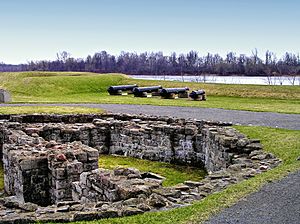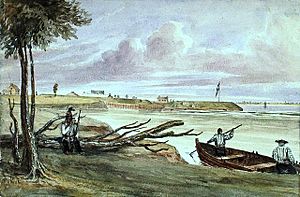Coteau-du-Lac canal facts for kids
The Coteau-du-Lac Canal is a very old military canal in Canada. It was built in the 1700s! You can find it in Quebec, where the Delisle and Saint Lawrence Rivers meet. This canal was the first of its kind in all of North America.
Today, it is a special place called a National Historic Site of Canada. The site also includes the remains of an old fort and a rebuilt blockhouse. It is located in the town of Coteau-du-Lac.
Why the Canal Was Built
During the American Revolutionary War (a big fight between Britain and the American colonies from 1775 to 1783), Britain found a problem. It was hard to get supplies and soldiers to their military bases. These bases were located near the Great Lakes and protected Canada's western border.
Moving supplies and troops along the Saint Lawrence River was very slow. This was because of fast-moving water called rapids upstream from Montreal. The rapids at Coteau-du-Lac were the hardest to pass. Going around them by land took even longer.
To make it faster to send military supplies west, Governor Frederick Haldimand gave an order. He wanted a canal dug at Coteau-du-Lac. A canal is like a man-made river that helps boats avoid difficult parts of a natural river.
Building the Canal
Work on the Coteau-du-Lac canal started in 1779. Captain William Twiss was in charge of the project. Soldiers from the King's Royal Regiment of New York helped dig the canal. It was a huge effort to build something like this by hand!
The canal was finished on February 15, 1781. It had a system of locks to help boats move up and down. The whole lock system was about 100 metres (330 ft) (328 feet) long. Each of the three locks was 12 metres (39 ft) (39 feet) long and 1.8 metres (5 ft 11 in) (6 feet) wide. Boats could have a draft (how deep they sit in the water) of up to 76 centimetres (30 in) (30 inches).
These locks helped boats get past a drop of about 2 metres (6 ft 7 in) (6.5 feet) in the river's height. Later, a newer canal called the Beauharnois Canal took its place.
Today, water no longer flows through the canal or around the site. This is because of lower water levels. Newer hydroelectric dams and other modern buildings have changed the river.
Legacy of Coteau-du-Lac
The Coteau-du-Lac site is an important part of Canadian history. It shows how people solved problems to move goods and protect their land.
On June 28, 1985, Canada Post released a special stamp. It was called 'Fort at Coteau-du-Lac'. This stamp was part of a series about "Forts Across Canada." It helps remember the importance of this historic place.



